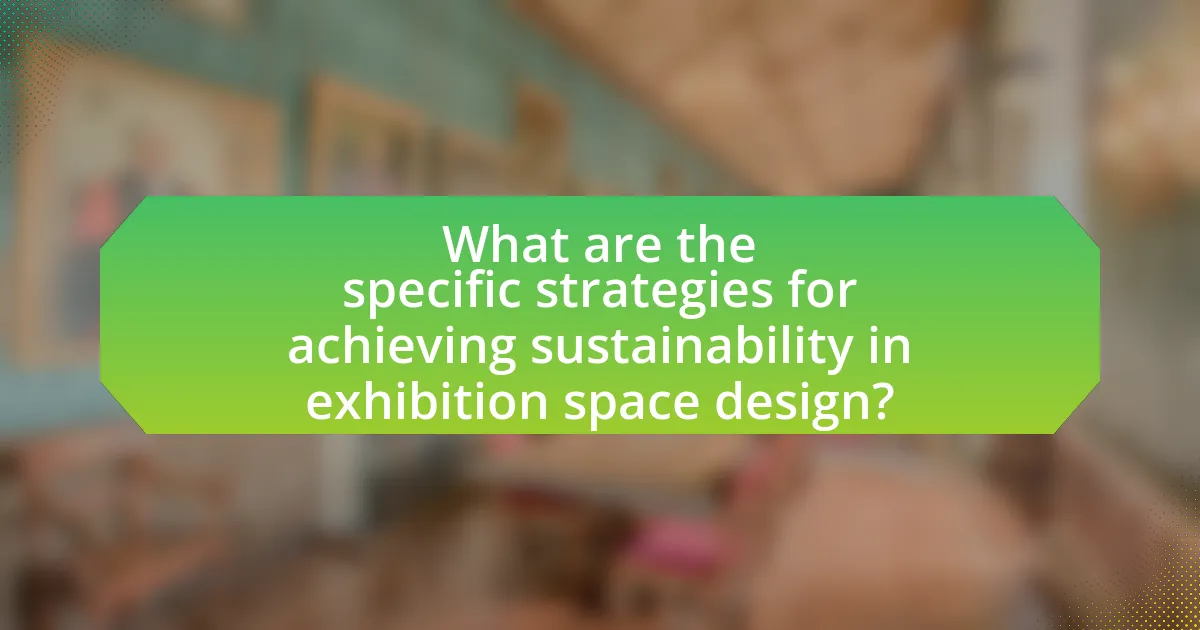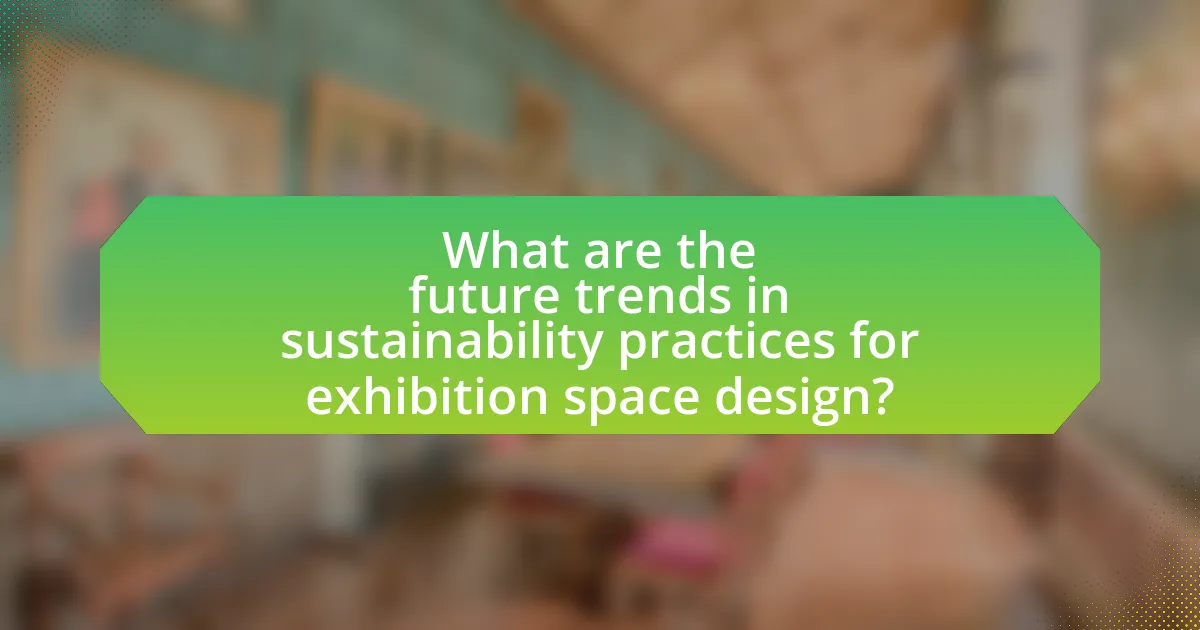Sustainability practices in exhibition space design focus on minimizing environmental impact while maximizing resource efficiency. Key strategies include the use of eco-friendly materials, energy-efficient lighting and HVAC systems, and waste reduction through recycling and composting. The article outlines the influence of these practices on design, the principles of sustainable design, and their impact on visitor experience. It also addresses the importance of sustainability in enhancing brand image, the challenges faced in implementation, and future trends in sustainable exhibition practices. Additionally, it provides practical tips for exhibitors to adopt sustainable design and resources available for effective implementation.

What are Sustainability Practices in Exhibition Space Design?
Sustainability practices in exhibition space design involve strategies that minimize environmental impact while maximizing resource efficiency. These practices include using eco-friendly materials, implementing energy-efficient lighting and HVAC systems, and designing for waste reduction through recycling and composting initiatives. For instance, the use of sustainable materials like reclaimed wood or recycled metals can significantly lower the carbon footprint of the exhibition space. Additionally, integrating renewable energy sources, such as solar panels, can further enhance energy efficiency. According to the U.S. Green Building Council, buildings designed with sustainability in mind can reduce energy consumption by up to 30%.
How do sustainability practices influence exhibition space design?
Sustainability practices significantly influence exhibition space design by prioritizing eco-friendly materials, energy efficiency, and waste reduction. Designers increasingly select sustainable materials such as recycled metals and biodegradable plastics, which minimize environmental impact. Additionally, energy-efficient lighting and HVAC systems are integrated to reduce energy consumption, aligning with the global push for lower carbon footprints. Research indicates that incorporating these practices can lead to a 30% reduction in energy use in exhibition spaces, demonstrating their effectiveness in promoting sustainability. Furthermore, waste management strategies, such as reusing exhibition components and implementing recycling programs, enhance the overall sustainability of the design.
What are the key principles of sustainable design in exhibitions?
The key principles of sustainable design in exhibitions include resource efficiency, waste reduction, and the use of sustainable materials. Resource efficiency focuses on minimizing energy and water consumption throughout the exhibition’s lifecycle, which can be achieved through energy-efficient lighting and water-saving fixtures. Waste reduction emphasizes designing for reuse and recycling, ensuring that materials can be repurposed after the exhibition ends. The use of sustainable materials involves selecting products that are renewable, recyclable, or have a low environmental impact, such as bamboo or recycled metals. These principles are supported by the growing emphasis on sustainability in the exhibition industry, as evidenced by initiatives like the ISO 20121 standard for sustainable event management, which encourages organizations to adopt these practices.
How do these principles impact the overall exhibition experience?
Sustainability principles significantly enhance the overall exhibition experience by creating environmentally responsible spaces that engage visitors. These principles, such as using renewable materials, energy-efficient lighting, and waste reduction strategies, contribute to a more immersive and educational environment. For instance, exhibitions designed with sustainable practices often incorporate interactive displays that inform attendees about ecological impacts, fostering a deeper connection to the subject matter. Research indicates that 70% of visitors prefer exhibitions that prioritize sustainability, demonstrating that these practices not only improve visitor satisfaction but also encourage greater attendance and participation.
Why is sustainability important in exhibition space design?
Sustainability is important in exhibition space design because it minimizes environmental impact while promoting resource efficiency. Sustainable design practices reduce waste, lower energy consumption, and utilize eco-friendly materials, which contribute to a healthier planet. For instance, according to the U.S. Green Building Council, buildings designed with sustainability in mind can reduce energy use by 30% to 50%. This not only benefits the environment but also enhances the overall experience for visitors, as sustainable spaces often incorporate natural elements and improved air quality.
What environmental benefits arise from sustainable exhibition practices?
Sustainable exhibition practices lead to significant environmental benefits, including reduced waste generation, lower carbon emissions, and enhanced resource efficiency. By utilizing recyclable materials and minimizing single-use items, these practices decrease the volume of waste sent to landfills. For instance, a study by the Green Exhibitor Network found that implementing sustainable practices can reduce waste by up to 70% in exhibition settings. Additionally, sustainable exhibitions often incorporate energy-efficient technologies, which can lower carbon footprints by as much as 30%, as reported by the International Association of Exhibitions and Events. Furthermore, these practices promote the use of sustainable resources, such as renewable energy sources, which contribute to a more sustainable ecosystem overall.
How does sustainability enhance the brand image of exhibitors?
Sustainability enhances the brand image of exhibitors by demonstrating a commitment to environmental responsibility, which resonates with increasingly eco-conscious consumers. This commitment can lead to improved customer loyalty, as studies show that 66% of global consumers are willing to pay more for sustainable brands. Additionally, sustainable practices can differentiate exhibitors in a competitive market, attracting attention and positive media coverage. For instance, companies that adopt green certifications often experience enhanced reputation and trust, as evidenced by a Nielsen report indicating that 73% of millennials are willing to pay extra for sustainable offerings.
What challenges are faced in implementing sustainability in exhibition design?
Implementing sustainability in exhibition design faces several challenges, including high costs, material sourcing, and stakeholder buy-in. High costs often deter organizations from adopting sustainable practices, as eco-friendly materials and technologies can be more expensive than traditional options. Material sourcing presents difficulties due to the limited availability of sustainable materials that meet aesthetic and functional requirements. Additionally, gaining stakeholder buy-in is challenging, as various parties may prioritize short-term gains over long-term sustainability goals, complicating decision-making processes. These challenges hinder the effective integration of sustainable practices in exhibition design.
What are the common barriers to adopting sustainable practices?
Common barriers to adopting sustainable practices include high initial costs, lack of awareness, and insufficient regulatory support. High initial costs deter organizations from investing in sustainable technologies and materials, as they often perceive them as financially burdensome despite long-term savings. Lack of awareness among stakeholders about the benefits and methods of sustainability leads to resistance in implementation. Additionally, insufficient regulatory support creates an environment where there are no incentives or mandates to encourage sustainable practices, further hindering adoption. These barriers are documented in various studies, including the “Barriers to Sustainable Practices in the Built Environment” report by the World Green Building Council, which highlights financial, educational, and policy-related challenges faced by organizations.
How can these challenges be overcome in the design process?
Challenges in the design process can be overcome by integrating sustainable materials and practices from the outset. By prioritizing eco-friendly materials, designers can reduce environmental impact; for instance, using recycled or locally sourced materials minimizes carbon footprints. Additionally, incorporating energy-efficient technologies, such as LED lighting and renewable energy sources, can significantly lower energy consumption during exhibitions. Research indicates that sustainable design not only enhances environmental performance but also improves visitor experience and engagement, as seen in the 2019 Green Building Council report, which highlights that 75% of attendees prefer eco-conscious exhibitions. Implementing these strategies ensures that sustainability is a core component of the design process, effectively addressing challenges related to resource use and waste management.

What are the specific strategies for achieving sustainability in exhibition space design?
Specific strategies for achieving sustainability in exhibition space design include utilizing eco-friendly materials, implementing energy-efficient lighting, and incorporating modular designs. Eco-friendly materials, such as recycled or sustainably sourced products, reduce environmental impact and promote resource conservation. Energy-efficient lighting, including LED technology, significantly lowers energy consumption, contributing to reduced carbon footprints. Modular designs allow for reusability and adaptability of exhibition components, minimizing waste and promoting longevity in design. These strategies collectively enhance sustainability in exhibition spaces by addressing material use, energy consumption, and waste management.
How can materials be selected for sustainable exhibition design?
Materials for sustainable exhibition design can be selected by prioritizing renewable, recyclable, and locally sourced options. This approach minimizes environmental impact by reducing carbon footprints associated with transportation and production. For instance, using bamboo, which is a fast-growing renewable resource, or recycled metals and plastics can significantly lower resource depletion. Additionally, selecting materials with low volatile organic compounds (VOCs) ensures better indoor air quality, aligning with sustainability goals. Research indicates that sustainable materials can reduce waste by up to 90% in exhibition setups, demonstrating their effectiveness in promoting eco-friendly practices.
What types of materials are considered sustainable for exhibitions?
Sustainable materials for exhibitions include recycled materials, biodegradable products, and sustainably sourced natural materials. Recycled materials, such as reclaimed wood and recycled metals, reduce waste and energy consumption associated with new production. Biodegradable products, like plant-based plastics and organic textiles, minimize environmental impact after disposal. Sustainably sourced natural materials, such as bamboo and cork, are renewable and have a lower carbon footprint compared to conventional materials. These choices align with sustainability practices in exhibition space design by promoting resource conservation and reducing ecological harm.
How does material choice affect the lifecycle of an exhibition?
Material choice significantly impacts the lifecycle of an exhibition by influencing its environmental footprint, durability, and adaptability. Sustainable materials, such as recycled or locally sourced options, reduce resource depletion and waste generation, thereby enhancing the exhibition’s ecological sustainability. For instance, using biodegradable materials can minimize landfill contributions at the end of the exhibition’s life. Additionally, durable materials extend the lifespan of exhibition components, allowing for reuse in future events, which further decreases overall resource consumption. Research indicates that exhibitions utilizing sustainable materials can reduce carbon emissions by up to 30%, demonstrating the critical role of material selection in promoting sustainability within exhibition space design.
What role does energy efficiency play in exhibition space design?
Energy efficiency is crucial in exhibition space design as it reduces operational costs and minimizes environmental impact. By incorporating energy-efficient lighting, HVAC systems, and insulation, designers can significantly lower energy consumption, which is essential for sustainable practices. For instance, studies show that energy-efficient buildings can reduce energy use by 30-50%, leading to substantial cost savings and a lower carbon footprint. This focus on energy efficiency not only enhances the sustainability of the exhibition space but also aligns with growing industry standards and consumer expectations for environmentally responsible practices.
How can lighting and HVAC systems be optimized for sustainability?
Lighting and HVAC systems can be optimized for sustainability by implementing energy-efficient technologies and smart controls. Energy-efficient LED lighting reduces electricity consumption significantly, with studies showing that LEDs use up to 75% less energy than traditional incandescent bulbs. Additionally, integrating smart thermostats and occupancy sensors in HVAC systems can optimize energy use by adjusting heating and cooling based on real-time occupancy data, leading to energy savings of 10-30%. Furthermore, utilizing natural light through design elements like skylights can reduce reliance on artificial lighting, enhancing energy efficiency. These strategies collectively contribute to lower carbon footprints and operational costs in exhibition spaces.
What technologies support energy-efficient exhibition spaces?
Energy-efficient exhibition spaces are supported by technologies such as LED lighting, smart HVAC systems, and renewable energy sources like solar panels. LED lighting consumes up to 75% less energy than traditional incandescent bulbs, significantly reducing electricity usage in exhibition areas. Smart HVAC systems optimize heating and cooling based on occupancy and environmental conditions, leading to further energy savings. Additionally, integrating solar panels can provide a sustainable energy source, potentially covering a significant portion of the energy needs for the exhibition space. These technologies collectively contribute to lower operational costs and reduced environmental impact, aligning with sustainability practices in exhibition space design.
How can waste management be integrated into exhibition design?
Waste management can be integrated into exhibition design by incorporating recycling stations, composting options, and sustainable materials throughout the exhibition space. This approach not only minimizes waste generation but also encourages attendees to participate in responsible disposal practices. For instance, using signage to clearly mark recycling and composting bins can increase proper waste sorting by up to 50%, as evidenced by studies conducted at various events. Additionally, selecting materials that are recyclable or biodegradable for exhibits and displays further reduces the environmental impact, aligning with sustainability goals in exhibition design.
What strategies can be employed to minimize waste during exhibitions?
To minimize waste during exhibitions, organizers can implement strategies such as using modular and reusable display materials, which significantly reduce single-use items. Research indicates that modular designs can decrease waste by up to 30% compared to traditional setups, as they allow for easy reconfiguration and reuse across multiple events. Additionally, digital solutions like virtual brochures and online ticketing can eliminate the need for printed materials, further reducing paper waste. Implementing a waste management plan that includes recycling and composting stations can also enhance waste diversion rates, with studies showing that effective waste management can lead to a 50% reduction in landfill contributions during events.
How can recycling and composting be effectively implemented?
Recycling and composting can be effectively implemented by establishing clear guidelines and accessible systems for waste separation. Organizations should provide labeled bins for recyclables and compostables in strategic locations to encourage proper disposal. Research indicates that when recycling bins are placed next to trash bins, recycling rates can increase by up to 50% (EPA, 2021). Additionally, educational programs can raise awareness about the benefits of recycling and composting, leading to higher participation rates. For instance, cities that have implemented community composting initiatives have reported a reduction in landfill waste by 30% (City of San Francisco, 2020).

What are the future trends in sustainability practices for exhibition space design?
Future trends in sustainability practices for exhibition space design include the increased use of modular and reusable materials, integration of smart technology for energy efficiency, and a focus on biophilic design. Modular and reusable materials reduce waste and allow for flexible configurations, while smart technology, such as IoT devices, optimizes energy consumption and enhances visitor experience. Biophilic design, which incorporates natural elements, has been shown to improve well-being and engagement, aligning with the growing demand for healthier environments. According to a report by the World Green Building Council, buildings that incorporate these sustainable practices can reduce energy consumption by up to 50%, highlighting their effectiveness and relevance in future exhibition space design.
How is technology shaping sustainable exhibition design?
Technology is shaping sustainable exhibition design by enabling the use of eco-friendly materials, energy-efficient systems, and innovative digital solutions. For instance, advancements in 3D printing allow designers to create structures using biodegradable materials, reducing waste and resource consumption. Additionally, smart lighting and HVAC systems optimize energy use, significantly lowering the carbon footprint of exhibition spaces. Research indicates that incorporating digital displays and virtual reality can minimize the need for physical materials, further promoting sustainability. According to a study by the Green Building Council, exhibitions that utilize these technologies can reduce energy consumption by up to 30%, demonstrating the tangible impact of technology on sustainable design practices.
What innovations are emerging in sustainable materials and practices?
Innovations in sustainable materials and practices include the development of biodegradable plastics, recycled materials, and energy-efficient technologies. Biodegradable plastics, such as polylactic acid (PLA), are derived from renewable resources and decompose more quickly than traditional plastics, reducing environmental impact. Recycled materials, like reclaimed wood and metal, are increasingly used in construction and design, minimizing waste and resource consumption. Energy-efficient technologies, including LED lighting and smart building systems, optimize energy use in exhibition spaces, contributing to lower carbon footprints. These advancements are supported by research indicating that sustainable practices can significantly reduce environmental harm while promoting resource conservation.
How can virtual and hybrid exhibitions contribute to sustainability?
Virtual and hybrid exhibitions contribute to sustainability by significantly reducing the carbon footprint associated with traditional in-person events. These formats eliminate the need for extensive travel, which accounts for a large portion of greenhouse gas emissions; for instance, a study by the Carbon Trust found that travel can contribute up to 70% of the total carbon footprint of an event. Additionally, virtual exhibitions minimize the consumption of physical materials, such as printed brochures and booth construction materials, further decreasing waste. By leveraging digital platforms, organizers can reach a global audience without the environmental impact of logistics and venue operations, thus promoting a more sustainable approach to event management.
What are the best practices for exhibitors to adopt sustainable design?
Exhibitors can adopt sustainable design by utilizing eco-friendly materials, implementing energy-efficient technologies, and minimizing waste. Eco-friendly materials, such as recycled or sustainably sourced products, reduce environmental impact and promote sustainability. Energy-efficient technologies, including LED lighting and renewable energy sources, lower energy consumption and carbon footprint. Additionally, minimizing waste through practices like reusing booth components and recycling materials contributes to a more sustainable exhibition. According to a study by the Green Building Council, using sustainable materials can reduce resource consumption by up to 30%, highlighting the effectiveness of these practices in promoting sustainability in exhibition space design.
How can exhibitors measure the effectiveness of their sustainability efforts?
Exhibitors can measure the effectiveness of their sustainability efforts by utilizing key performance indicators (KPIs) such as waste reduction, energy consumption, and attendee feedback. For instance, tracking the amount of waste diverted from landfills through recycling and composting initiatives provides quantifiable data on waste management success. Additionally, monitoring energy usage before, during, and after the event can reveal improvements in energy efficiency, with studies indicating that sustainable practices can reduce energy consumption by up to 30%. Attendee feedback, gathered through surveys, can also assess perceptions of sustainability efforts, with research showing that 70% of attendees value sustainability in exhibitions. These metrics collectively offer a comprehensive view of the impact and effectiveness of sustainability initiatives in exhibition spaces.
What resources are available for exhibitors seeking to implement sustainable practices?
Exhibitors seeking to implement sustainable practices can access various resources, including industry guidelines, certification programs, and educational materials. The Sustainable Exhibiting Guide by the Exhibitor Magazine provides actionable strategies for reducing waste and energy consumption during events. Additionally, organizations like the Green Meeting Industry Council offer certification programs such as APEX/ASTM, which help exhibitors align with recognized sustainability standards. Research from the Event Industry Council indicates that sustainable practices can enhance brand reputation and attendee satisfaction, further validating the importance of these resources.
What practical tips can be applied to enhance sustainability in exhibition space design?
To enhance sustainability in exhibition space design, utilize modular and reusable materials for construction and displays. This approach minimizes waste and reduces the need for new resources, as modular designs can be easily adapted for future events. Additionally, incorporating energy-efficient lighting and HVAC systems can significantly lower energy consumption, with studies indicating that LED lighting can reduce energy use by up to 75% compared to traditional lighting. Implementing digital displays instead of printed materials also decreases paper waste, aligning with sustainable practices. Furthermore, sourcing materials locally can reduce transportation emissions, supporting local economies while promoting sustainability.






